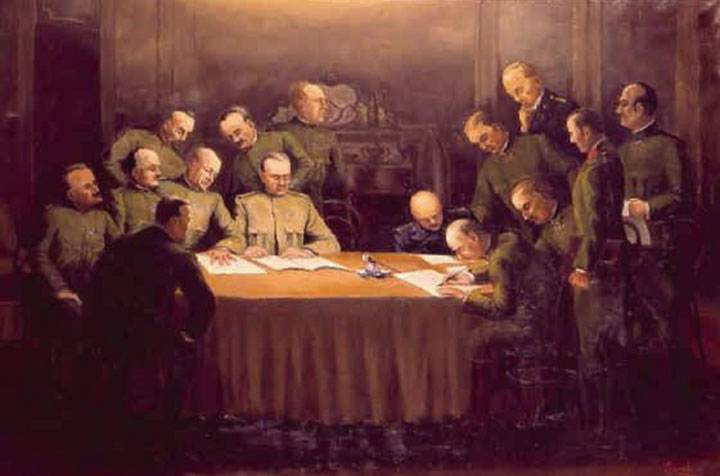
Cenno Storico – La Prima Guerra Mondiale
On the Italian front the catastrophic First World War ended when decisive battles, under the command of General Armando Diaz, were fought and won by the Italian troops against the occupying Austro-Hungarian troops. The main battles took place on the river Piave, on Monte Grappa and around Vittorio Veneto in the N-E region of Veneto.
The victorious troops reached Trieste on 3 November 1918 and on the same day the Armistice of Villa Giusti was signed at Padua. The Armistice, however, took effect the following day.
The war marked the end of the Austro-Hungarian Empire, with casualties in the hundreds of thousands and the capture of some 350,000 of its troops.
WW1 had started on 28 July 1914 and ended on 11 November 1918 when Germany, the last of the central empires, surrendered.
Also known as the Great War, it mobilised about 70 million soldiers from many parts of the world, including the United States. Nine million of these died together with seven million civilians. It is estimated that the war, the associated famine and the Spanish flu epidemic that spread during this period accounted for a toll ranging between 50 and 100 million people. Italian military casualties numbered 680.000 while a further 270.000 were injured.
Each year Italy commemorates the end of WW1 on 4 November, also known as Armed Forces and National Unity Day as it completed the unification of Italy when Trento and Trieste were liberated from the Austro-Hungarian Empire.
Sul fronte italiano la catastrofica I Guerra Mondiale terminò con battaglie decisive, sotto il comando del generale Armando Diaz, combattute dalle truppe italiane contro le truppe austro-ungariche che avevano occupato il territorio del nord-est. Le principali battaglie ebbero luogo nel Veneto sul fiume Piave, sul Monte Grappa e nella zona di Vittorio Veneto.
Le truppe vittoriose raggiunsero Trieste il 3 novembre 1918 e lo stesso giorno fu firmato l’Armistizio di Villa Giusti a Padova, che però entrò in vigore il giorno seguente.
La guerra segnò la fine dell’impero austro-ungarico, che dovette lamentare centinaia di migliaia di morti e circa 350.000 dei suoi soldati furono fatti prigionieri.
La I Guerra Mondiale era iniziata il 28 luglio 1914 e si concluse l’11 novembre 1918 quando la Germania, ultimo degli imperi centrali, depose le armi.
Conosciuta anche come la Grande Guerra, mobilitò circa 70 milioni di soldati di molti paesi del mondo, compresi gli Stati Uniti. Nove milioni di questi morirono, assieme a sette milioni di civili. Si stima che la guerra, le carestie che l’accompagnarono e l’epidemia di febbre spagnola, diffusasi nello stesso periodo, causarono la morte di 50-100 milioni di persone. Il numero di soldati italiani deceduti in questo conflitto fu di 680.000, e ne rimasero feriti altri 270.000.
Ogni anno l’Italia commemora la fine della I Guerra Mondiale il 4 novembre, data conosciuta anche come la Festa delle Forze Armate e dell’Unità Nazionale dato che completò l’unificazione del paese sottraendo Trento e Trieste all’impero austro-ungarico.
Yvette Devlin

